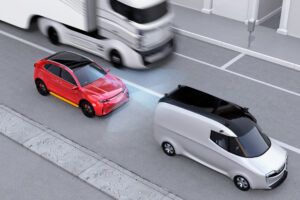
CNN article focuses on rising complexity of collision repair
By onMarket Trends | Technology
A recent CNN Business article focused on the rising complexity of collision repairs, even for minor fender benders, due to the increasing use of technology in vehicles.
“The change that we’ve seen in the last five years is greater than we’ve seen, probably, in the last five decades,” said Todd Dillender, chief operating officer of Caliber Collision, in the article.
Advanced driver assistance systems (ADAS) including automatic emergency braking (AEB), blind spot monitoring, and lane departure warning can increase repair costs by up to 37.6% after a crash, according to a recent study by AAA.
“Even minor damage to systems such as front radar or distance sensors can result in additional repair expenses up to $1,540,” the study says.
The increase partly comes from the cost of replacing and calibrating sensors, it said.
While OEMs are adding more ADAS features, the National Highway Traffic Safety Administration (NHTSA) is also demanding it.
NHTSA recently finalized a new Federal Motor Vehicle Safety Standard (FMVSS) that will make AEB, including pedestrian AEB (PAEB), standard on all passenger cars and light trucks by September 2029.
AEB systems use sensors to detect when a vehicle is close to crashing into a vehicle or pedestrian in front and automatically apply the brakes if the driver doesn’t. PAEB technology detects a pedestrian in both daylight and at night.
Dave Gruskos, Reliable Automotive Equipment, Inc. president, told Repairer Driven News the evolution of technical advancements that started with companies, such as Mercedes-Benz, 25 years ago used to take a decade or more to become industry-wide. He said now, similar advancements can be widespread within a year of introduction to the industry.
“Everything is evolving to the next level,” Gruskos said. “There is no simple vehicle.”
The CNN article talks about the importance of having the technology repaired correctly.
“You’re changing the way the sensor looks out in the world,” said Hami Ebrahimi, chief commercial officer at Caliber, in the article.
A misalignment can make a “big difference” in how the vehicle perceives where another vehicle or object is, the article says.
The article also explains how each OEM can have a different process for repairs. It adds this could even be different per model.
It further explains the difference between static and dynamic calibrations and the difficulty repairers face with each. For example, repairers need specific conditions to test drive a vehicle for a dynamic calibration.
“If you’re in Chicago or L.A., good luck getting to that speed,” said Ebrahimi. “Or if you’re in Seattle or Chicago or New York with snow, good luck picking up all the road markings.”
The article also acknowledges the extra expenses repair shops face in needing advanced infrastructure and a specialized workforce.
“With a rapidly changing industry, qualified auto body repair technicians are in short supply, just as they are in the engine repair business,” the article says.
ADAS is not the only advancement causing more complex repairs, Gruskos said.
“Modern vehicles are increasingly incorporating advanced materials such as aluminum, carbon fiber, and high-strength steel to reduce weight and enhance fuel efficiency,” Gruskos said. “Repairing these materials requires specialized knowledge, equipment, and techniques compared to traditional steel body panels.”
For example, metal gigacast requires repairers to use a very precise technique to punch a hole for a rivet, Gruskos said. He said the cast can crack if done incorrectly.
Electric vehicles bring their own unique requirements including high-voltage systems and battery repairs, Gruskos said. He said both can be dangerous, and even deadly, for anyone who hasn’t received specialized training.
Technology also is being introduced to every component of vehicles, Gruskos said.
“As vehicles become more technologically advanced, even seemingly unrelated components like air conditioning units and radios can pose challenges during repair,” Gruskos said. “Technicians may need to be trained in diagnosing and repairing issues with these systems, which may involve both mechanical and electronic components.”
Gruskos added that as the complexity increases, so does the cost to the repair shop.
“Adapting to these changes requires ongoing investment in training, equipment, and infrastructure to ensure that repair shops can effectively address the complex needs of modern vehicles,” Gruskos said.
IMAGES
Photo courtesy of Chesky_W/iStock
